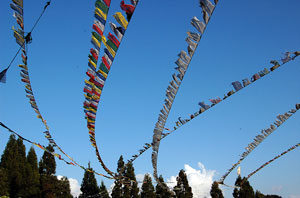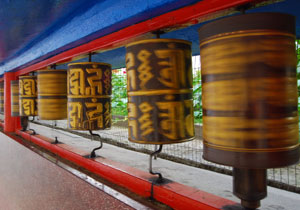|
|
|
Sikkim Culture |
|
|
|
Holy Structures in Sikkim |
|
|
|
The
Prayer Flags
The Prayer Flags can be seen almost any where in Sikkim
on hilltops or on building tops. These flags are an
integral part of the landscape of Sikkim. These flags
have prayers inscribed on them. There are four types of
Prayer flags. Lungta or wind Horse are strips of clothes
attached with bamboo poles. These flags have the figure
of a horse with the mystical jewel on its back. Chopen
or luck flag are long, narrow oblong in shape. These
types of flags are tied on twigs of trees, bridges and
top of hills. Gyalsten or Victorious Banner has a large
amount of holy text on them including the eight lucky
signs. Glan-po stob ryyas or |
 |
|
|
Vast lucky
flag include symbols such as crossed Dorjee in the centre with
a peacock.
Bodhisattva (Buddhas in
the making)
Most of the monasteries in Sikkim contain the idols of the
Bodhisattvas of Avalokitesvara, Padmasambhava, Manjusri and
Tara. Some monasteries also have an image of some form of
Buddha. There are a few monasteries which emphasize on the
Tantric form of worship and have the Bodhisattva depicted in
the Yab-Yum (Father-Mother) pose with a female Shakti. Some of
the Bodhisattvas are briefly described below.
Avalokitesvara or Chenrezi
He is the leading celestial being in Buddhism and the Lord of
Compassion. He is said to be the saviour of beings alive. He
is manifested in 108 different forms. The most popular form is
with 11 heads. The Dalai Lama is said to be the reincarnation
of Avalokitesvara.
Amitaba or Opame
This deity holds a pot of ambrosia in his hand. His earthly
manifestation in Tibet is the Panchen Lama.
Padmasambhava
He was a Guru who traveled to Lhasa in the eight century and
was instrumental in spreading Buddhism in Tibet. He is
depicted normally holding a thunderbolt in his right hand and
a bowl made of human skull in the left hand. There are
three heads on the spear beside the Guru: a skull, a head with
blood and flesh and a head with signs of life. The heads
represent the doctrine of Three Bodies.
Mirlrepa
This great mystic of Tibet renounced all earthly possessions
and he has only a bowl of human skull for storing food. He
always has his right ear pointing towards the sky as if in
constant communication with the Almighty.
Manjusri
He is also known as the Deity of Knowledge and carries a Sword
of Wisdom in right hand.
Tara
She is female Bodhisattva and is said to be the saviouress.
She has many types of forms. |
|
|
|
Chortens or stupas
Chortens or stupas dot every nook and corner Sikkim.
Chortens are normally found concentrated around
monasteries. In old times, the chortens were built as
relic holders but now they are erected in the memory of
Lord Buddha or some Buddhist saints. Though chortens
vary in size with some as high as a four storied
building, their shapes are more or less the same. The
shape of the chorten symbolizes the five elements of
nature namely earth, water, fire, air and ether to which
a body is transformed after death. The rectangular base
represents the earth whereas the globe atop this depicts
water. Resting on the globe is a triangular structure
which signifies fire. On |
 |
|
|
the tip of
the triangular is a crescent that represents air. Nested in the
crescent is a small oval structure which symbolizes each other.
Bell & Thunderbolt
The bell and the Thunderbolt signify the two truths. The bell
or Thribu symbolizes that everything in the end is void and
the thunderbolt or Dorjee signifies the immortality of Truth.
The Bell is held in the right hand and the Thunderbolt in the
left during rituals.
Khada or Scarf
Khadas are long length of silk cloth in the form of a scarf
that besides being used as an offering to the gods are also
presented at social occasions such as marriage, birthday or
funeral. The method of presenting khadas vary according to the
status of the person it is being offered to. To one who is
superior to you, you should raise it in both hands to the
height of the forehead while to the one who is of equal
status, you have to raise it in both hands at your shoulder
level and present it in his hands. You can also accept one in
return from him whom you presented. To one who is below in
status or age, you should put the scarf around his neck with
the free ends kept hanging in front. To the bereaved, the
khada is folded and offered. |
|
|
|
Prayer wheel & Rosary
The Prayer Wheel is a religious implement on which some
holy mantra is inscribed and which is held in the hand
and rotated with the motion of the wrist. There are also
the bigger type of prayer Wheels which surround
monasteries or chortens. For instance, Phurba-Chorten
near Tibetology in Gangatok is surrounded by 108 prayer
wheels which are rotated by devotees when they go around
the chorten. One can also see prayer wheels in streams
the flowing water of which rotate them. The Rosary
consists of 108 beads made of small pellets of wood,
ivory or precious stones. While telling the beads, holy
mantras are chanted. |
 |
|
|
|
|